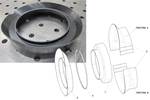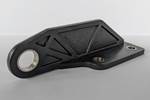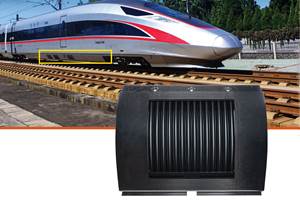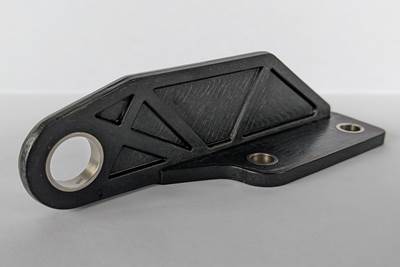Biogear landing gear demonstrates a hybrid composite structure with visible carbon fiber/flax sections (black) and metallic interface components (silver). Source (All Images) | Fuko
Substituting metallic structures with composite materials presents a promising strategy for reducing the weight of aerospace components. However, integrating this approach into high-impact structures, such as helicopter landing gear, poses unique challenges that test standard composite engineering methodologies, requiring innovative solutions to meet safety and performance requirements.
Conventional metallic landing gear relies on elastic deformation to dissipate energy and plastic deformation to create a controlled failure mechanism. This well-established design approach enables the landing gear to absorb significant loads without transmitting damaging forces to the fuselage or tail, as long as they do not touch the ground. In contrast, traditional composite structures are typically too rigid to perform in the same manner, necessitating new approaches to achieve similar safety characteristics.
Aerospace consulting firm Fuko (Rome, Italy) collaborated with Turtle Srl. (Bologna, Italy), an engineering company spin-off from the University of Bologna, to develop a lightweight helicopter landing gear option. The duo’s design, called Biogear, combines carbon fiber-reinforced polymer (CFRP) and flax fiber-reinforced polymer to reduce weight and thereby increase payload capacity, as well as enhance rotorcraft operational efficiency while maintaining the critical safety features of traditional metallic designs. Biogear achieves a 54% weight reduction compared to the metallic structure it replaces, demonstrating how seemingly contradictory material properties can be strategically combined to achieve desired performance in dynamic loading applications.
A depiction of the hybrid composite structure’s progressive layup sequence (left to right): full carbon fiber layup, introduction of flax fiber core and increased flax fiber content.
Landing gear specifications and design challenges
The Biogear design concept originated from a competitive initiative within the European Union's Horizon 2020-funded AMULET (Advanced Materials and Manufacturing Technologies United for Lightweight) project which offers thematic competitions, feasibility assessments, coaching and funding opportunities to elevate technology readiness levels (TRLs) from stages 4-5 to 7, thereby facilitating the transition from early-stage prototyping to market readiness. The program aims to advance lightweight materials and manufacturing processes within the framework of a decarbonized circular economy emphasizing the development and optimization of polymer-based composites, ceramic matrix composites and lightweight metal alloys to minimize mass while enhancing overall performance.
The competition Fuko entered focused on designing skid-type landing gear for a light helicopter where shape, size, maximum weight and landing gear attachment configuration were specified, creating an engineering challenge within strict constraints. The winner would be the team who could produce the lowest weight landing gear while maintaining or improving the performance of the landing gear system.
“The skid interfaces with the ground rails and the attachment mechanism to the fuselage was non-negotiable; any modifications would lead to incompatibility,” states Professor Riccardo Panciroli, founder of Fuko and an engineering professor at Niccolò Cusano University, who led the Biogear project. “Thus, the scope for design innovation was limited to the selection of materials and their configuration.”
The competition prescribed a maximum takeoff weight of 600 kilograms and a weight limit of 15 kilograms for the entire landing gear assembly, which was the weight of the original metallic version. It needed to be 1.6 meters wide, 1 meter tall and 3 meters long while maintaining full compliance with European Aviation Safety Agency (EASA) certification for small rotorcraft CS-27. This certification mandates that the landing gear must withstand drop tests from 0.33 meters without any structural damage, and from 0.5 meters with allowances for controlled deformation.
“When designing metallic landing gear, engineers can reliably calculate loads based on mass and velocity using well-established homogeneous material engineering principles,” Panciroli explains. “However, with composite materials, the layup affects the impact forces in complex and sometimes counterintuitive ways. Making the structure too stiff can lead to dangerous force spikes over short timeframes potentially exceeding material limits, while excessive compliance can cause geometric nonlinearities that amplify bending moment — the point of highest bending stress under load — beyond acceptable levels, potentially compromising structural integrity. This relationship creates a complex optimization challenge that requires careful balance and innovative solutions.”
Advanced analysis and modeling
Total ground impact force profile during drop testing shows that the hybrid composite landing gear reached peak forces of approximately 41 kilonewtons at around 60 milliseconds. The gradual force buildup and decay illustrates the landing gear's ability to effectively absorb and distribute impact loads while preventing force spikes.
Understanding the complex dynamic behavior of composite landing gear required advanced analysis techniques that go beyond traditional composite design methods and static load calculations. “We needed to implement a sophisticated dynamic model using explicit finite element methods,” explains Panciroli. “The explicit approach accounts for time-dependent behaviors and inertial effects, which diverges significantly from traditional static load designs that use implicit models.”
The simulation framework had to capture multiple nonlinear phenomena simultaneously, accounting for geometric nonlinearities, complex friction effects during impact, and the intricate interaction between structural response and load generation throughout the impact event. Force-time analysis during impact demonstrated how ground friction coefficients significantly influence energy absorption, showing that friction can dissipate substantial impact energy, thereby reducing structural loads on the hybrid composite structure in ways that complement its inherent properties.
The analysis revealed that a hollow hybrid CFRP and flax fiber structure could achieve near-optimal stress distribution along the landing gear legs. It showed that the interaction between carbon fiber and flax sections creates a progressive energy absorption mechanism that cannot be achieved with either material alone. Additionally, it revealed that stress distribution at any given point can vary considerably throughout the wall thickness, a crucial finding for determining optimal fiber orientation and material transitions throughout the structure.
“We discovered that the wall thickness and layup configuration was the most critical aspect of the hybrid construction,” says Panciroli. “We saw that if we reduce thickness to decrease stiffness, we significantly limit the material’s load-bearing capacity and increase susceptibility to shear failures. Finding the optimal balance required extensive iteration and careful consideration of these complex factors.”
Energy distribution during landing impact tests shows the relationship between total, kinetic, internal, external work and friction energies over a 200-millisecond period. The graph demonstrates how the hybrid structure effectively manages and dissipates impact energy through various mechanisms.
Once the overall stiffness and compliance parameters were established, the partners could optimize the material distribution and layup strategy for maximum performance. “The landing gear essentially behaves like a complex arch structure, with the landing feet acting as dynamic points of support,” notes Panciroli. “While this might suggest using primarily unidirectional fibers to handle bending loads, such an approach would create excessive stiffness, leading to potentially dangerous force concentrations.
“We needed to think beyond conventional composite design approaches,” he continues. “We began experimenting with different layup sequences to identify the optimal configuration that could effectively achieve the desired performance and, importantly, could also be produced in the real world using available manufacturing techniques.”
Hybrid material selection and manufacturing considerations
The final structure features a hollow leg design with an undisclosed number of layers of prepreg material to generate the required wall thickness. A combination of CFRP with flax fiber varied strategically throughout the structure based on local loading requirements, ranges from 100% CFRP, to 80% flax fiber with 20% CFRP.
Carbon fiber and flax fiber were chosen for their complementary properties to meet the Biogear landing gear’s performance requirements. Carbon fiber, with its high strength-to-weight ratio and stiffness, is used in the curved upper section where the landing gear attaches to the helicopter. This area experiences the maximum bending moment requiring a material that resists deformation and maintains structural integrity.
Flax fiber, known for its superior energy absorption, natural compliance, and vibration damping properties, is applied in the lower leg sections that contact the ground. These areas must effectively absorb impact forces, reduce vibration, and allow controlled deformation to minimize the risk of catastrophic failure. Together, the materials are strategically distributed to optimize performance under dynamic loading conditions.
“The material composition transitions from predominantly carbon to nearly full flax [fiber] as one moves away from the maximum flexural moment,” says Panciroli. “This gradient approach allows for precise tuning of local stiffness while ensuring structural continuity.” The interface between the carbon and flax fiber sections takes particular advantage of the hybrid design; areas where the materials combine exhibit increased safety factors compared to sections made solely of one material, demonstrating the synergistic benefits of the hybrid approach.
“Where flax is present in the structure, the risk of catastrophic failure is significantly lower than in full carbon fiber sections,” highlights Panciroli. “Its natural compliance was validated through extensive laboratory testing, including comprehensive static and fatigue evaluations, to ensure long-term structural integrity under all operating conditions.”
Detail of a curved section component during manufacturing, showing the turquoise-colored mold used to shape the hybrid composite material.
Real-world coupon material testing revealed that T700 carbon fiber, despite offering 20% less strength than the aerospace industry standard T800, actually improved overall performance. Panciroli explains: “The stiffer T800 fibers exhibit lower deformation at the breaking point, which reduces the structure’s ability to absorb energy through elastic deflection. More critically, the increased stiffness results in higher peak impact loads, leading to dangerous shear stress concentrations.”
Manufacturing the complex hybrid structure required careful management of different thermal and mechanical properties during the consolidation process. “The stacking sequence relies on a solid understanding of the macro mechanics that govern the laminate behavior,” explains Panciroli. “In cases involving a thick, hollow, circular structure like this landing gear, the stress distribution varies considerably throughout that thickness, requiring precise control of the manufacturing process.”
Environmental testing revealed a significant potential vulnerability in the design: the flax fiber components are extremely susceptible to moisture absorption, which could severely compromise their mechanical properties over time. The team addressed this by implementing a protective sandwich structure with carbon fiber layers on the outer plies, effectively sealing the natural fiber components from environmental exposure while maintaining their beneficial mechanical properties.
Testing and performance validation
Comprehensive impact testing demonstrated impressive results that validated the design approach. During standard drop tests from 0.33 meters, Biogear experienced peak accelerations of up to 6G, with force distribution differing between front and rear legs in a controlled manner.
This drop test apparatus was designed for validating Biogear's performance. The system includes weight plates, a mechanical hoist and instrumentation setup to simulate landing impacts from heights of 0.33 meters and 0.5 meters as required by EASA certification standards.
The physical analysis indicated that flat surface impacts represent the most critical loading scenario, though additional scenarios — including tilted landings and single-leg contact — were also extensively tested. Results confirmed that the ground friction load-bearing concept could dissipate significant impact energy, augmenting the structure’s elastic deformation characteristics and providing superior performance.
“The use of flax components significantly enhances the potential for ground friction, as these materials provide superior vibration damping due to their natural viscoelastic properties,” notes Panciroli. “This quality helps manage dynamic loads and improves the overall performance of the landing gear under various operating conditions.”
The final Biogear design weighs 6.9 kilograms — just 46% of the original 15 kilogram metallic structure it replaces. This weight reduction demonstrates how seemingly contradictory material properties can be strategically combined to achieve high performance in dynamic loading applications.
“Biogear’s hybrid structure potentially opens new possibilities for integrating natural fibers into primary aerospace structures, theoretically influencing future composite manufacturing strategies across the aerospace industry,” notes Panciroli, “and paving the way for more sustainable and efficient aircraft components.”
Related Content
Carbon fiber composite pallet revolutionizes freight industry
LOG Point Pallet fuses advanced materials with innovative design and manufacturing to improve supply chains worldwide.
Read MoreCompositeWorld's top ten articles from our "Focus on Design" column
CW’s Focus on Design assists our readers in staying up to date on the latest trends and innovations in composite materials and design. Take a look at the top ten most read articles from our popular column.
Read MoreComposites-reinforced concrete for sustainable data center construction
Metromont’s C-GRID-reinforced insulated precast concrete’s high strength, durability, light weight and ease of installation improve data center performance, construction time and sustainability.
Read MoreComposite sidewall cover expands options for fire-safe rail components
R&D project by CG Rail explores use of carbon fiber-reinforced thermoplastics and recycled manufacturing scrap to meet fire safety, weight and volume targets.
Read MoreRead Next
Composite ring frame improves safety, cost for workhorse helicopter
Airbus Helicopters replaces aluminum primary structure with CFRP using multi-piece preform and single-shot infusion.
Read MoreOptimizing a thermoplastic composite helicopter door hinge
9T Labs used Additive Fusion Technology to iterate CFRTP designs, fully exploit continuous fiber printing and outperform stainless steel and black metal designs in failure load and weight.
Read MoreSpeeding RTM with heat-flux sensors
Clean Sky 2 INNOTOOL 4.0 project advances cure monitoring for larger and less costly lightweight landing gear made using composites.
Read More























